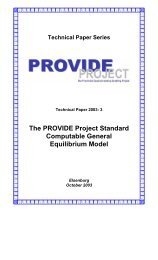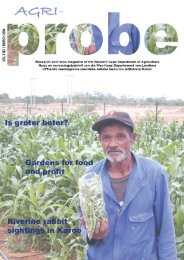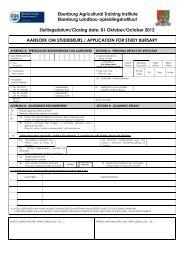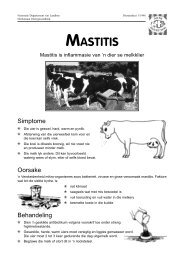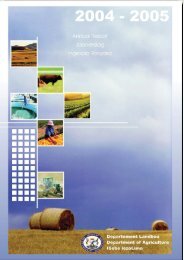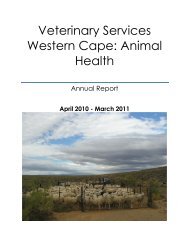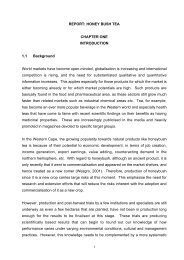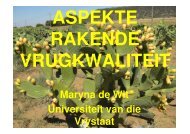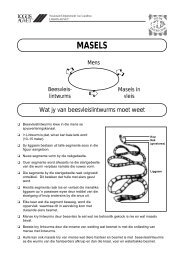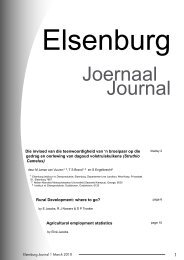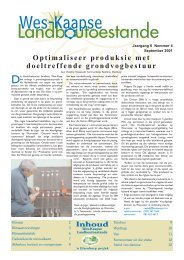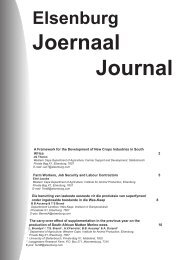Download Elsenburg Joernaal/Journal - Department of Agriculture ...
Download Elsenburg Joernaal/Journal - Department of Agriculture ...
Download Elsenburg Joernaal/Journal - Department of Agriculture ...
You also want an ePaper? Increase the reach of your titles
YUMPU automatically turns print PDFs into web optimized ePapers that Google loves.
1<br />
<strong>Elsenburg</strong><br />
<strong>Joernaal</strong><br />
<strong>Journal</strong><br />
A case report <strong>of</strong> Wesselsbron disease in sheep and a horse 2<br />
Sophette Gers and Jacob Stroebel<br />
Western Cape Provincial Veterinary Laboratory<br />
Private Bag X 5020, Stellenbosch, 7599<br />
E-mail: SophetteG@elsenburg.com<br />
Carbon Sequestration and Trading: An Opportunity for Farmers and 4<br />
Landowners to Earn Additional Income<br />
Bukelwa Grwambi: Principal Agricultural Economist.<br />
Agricultural Economics, Marketing Division<br />
Private Bag X1, <strong>Elsenburg</strong>. 7606<br />
Email: bukelwag@elsenburg.com<br />
Grondverskille moét in ag geneem word met stikst<strong>of</strong>bemestingsbeplanning 6<br />
J Labuschagne<br />
Instituut vir Plantproduksie<br />
Privaatsak X1, <strong>Elsenburg</strong>, 7606<br />
Email address: bukelwag@elsenburg.com<br />
Rumen inert fat or starch as supplementary energy sources for 9<br />
reproducing ewes grazing wheat stubble<br />
L. Brundyn 1,2 , T.S. Brand 1, # , A.V.Ferreira 2 , B.B. Aucamp 1 & A. Durand 3<br />
1 <strong>Elsenburg</strong> Agricultural Research Centre, Private Bag X1, <strong>Elsenburg</strong>, 7607<br />
2 University <strong>of</strong> Stellenbosch, Private Bag X1, Matieland, 7602<br />
3 Langgewens Experimental Farm, P.O. Box 271, Moorreesburg, 7310<br />
E-mail: TersB@elsenburg.colm<br />
<strong>Elsenburg</strong> <strong>Journal</strong><br />
2008 (3)
A case report <strong>of</strong> Wesselsbron disease in<br />
sheep and a horse<br />
Sophette Gers and Jacob Stroebel<br />
Western Cape <strong>Department</strong> <strong>of</strong> <strong>Agriculture</strong>, Provincial Veterinary Laboratory<br />
Introduction:<br />
Wesselsbron disease (WBD) is an insect borne viral infection<br />
<strong>of</strong> sheep, goats and cattle that derives its name from the district<br />
where it was first isolated from the organs <strong>of</strong> a lamb in 1955.<br />
It is reported to cause mortalities in new-born lambs and kids,<br />
subclinical infection in adult animals and occasionally abortion<br />
in ewes. Sheep and cattle foetuses can develop central nervous<br />
malformation resulting in musculo-skeletal contracture and<br />
rigidity (arthrogryposis). When humans are infected, a non-fatal<br />
influenza-like illness has been described. 1<br />
In February and March the State Veterinarian in Beaufort West<br />
submitted formalin fixed tissue to the Western Cape Provincial<br />
Veterinary Laboratory for histological evaluation. The samples<br />
originated from two unrelated cases. Merino lambs and mature<br />
ewes were dying with varying degrees <strong>of</strong> icterus being the most<br />
significant post mortem finding. Histological evaluation <strong>of</strong> the<br />
tissue revealed severe damage to the liver. The liver sections<br />
were characterised by single cell necrosis to severe extensive<br />
areas <strong>of</strong> coagulative necrosis. The remaining viable hepatocytes<br />
showed cellular swelling, fatty change, megalocytosis and<br />
anisonucleosis with accompanying Kupffer cell hyperplasia,<br />
mild fibrosis and bile duct proliferation. These lesions are suggestive<br />
<strong>of</strong> a toxic insult to the liver. Some examples <strong>of</strong> known<br />
hepatotoxic plants include Hertia pallens (Springbokbossie),<br />
Pteronia pallens (Scholtz-bossie), Asaemia axillaris (Vuursiektebossie)<br />
and even Aflatoxicosis which is a mycotoxicosis caused<br />
by Aspergillus flavus 2 . Presumptive diagnoses <strong>of</strong> plant toxicity<br />
were made, but considering the history and after consultation<br />
with Dr Pienaar, the wax embedded tissues were submitted to<br />
the Pathology department <strong>of</strong> the Veterinary Faculty at Onderstepoort<br />
for WBD immunoperoxidase staining. Serum collected<br />
from an affected lamb was also sent to the Onderstepoort<br />
Veterinary Institute for WBD antibody detection by complement<br />
fixation testing. Diffuse, intense positive staining for WBD <strong>of</strong><br />
the liver samples were reported and the lamb’s serum had very<br />
high antibody levels against WBD.<br />
Another interesting case involving a horse from Bonnievale<br />
were submitted in April to the Western Cape Provincial Veterinary<br />
Laboratory. Clinical signs included pyrexia at first, which<br />
progressed over 4 days from hind limb paresis, incoordination<br />
and weakness to complete paralysis. Euthanasia was elected<br />
and the horse was submitted for post mortem examination<br />
where no significant macroscopic lesions were found. Histological<br />
evaluation <strong>of</strong> nervous tissue revealed a severe, diffuse<br />
mononuclear meningo-encephalitis with widespread perivascular<br />
cuffing around the bloodvessels in the neuropil as well<br />
as meningitis. Multifocal neuronal necrosis with gliosis was a<br />
feature <strong>of</strong> the grey matter. No significant lesions were observed<br />
in any <strong>of</strong> the other parenchymal organs examined histologically.<br />
Classically this presentation is associated with numerous viral<br />
encephalitides, prompting ancillary diagnostic investigation.<br />
Immunoperoxidase staining for Equine Herpes, Equine Encephalosis,<br />
Rabies and African Horse Sickness viruses were all<br />
negative. Virus isolation and PCR (polymerase chain reaction)<br />
on fresh spleen and lung samples for Equine Encephalosis, Afri-<br />
can Horse Sickness and Equine Herpes viruses were negative.<br />
<strong>Elsenburg</strong> <strong>Joernaal</strong><br />
2008 (3)<br />
Wesselsbron virus infection was confirmed by dr. M Venter from<br />
the <strong>Department</strong> <strong>of</strong> Medical Virology, Faculty <strong>of</strong> Health Sciences,<br />
University <strong>of</strong> Pretoria using RT-PCR (reverse transcription polymerase<br />
chain reaction) on formalin fixed neural tissue.<br />
Discussion:<br />
Interestingly, mature sheep were affected in the one case, with<br />
no abortions reported in either <strong>of</strong> the two cases. Classically<br />
WBD causes sporadic abortion and mortalities in newborn animals.<br />
The histological appearance was deceptively reminiscent<br />
<strong>of</strong> a toxic insult to the liver.<br />
The described case in the horse was purportedly only the second<br />
confirmed case <strong>of</strong> WBD in this species, the details <strong>of</strong> which<br />
will be published elsewhere by dr. Venter. (personal communication)<br />
The other case recovered after showing neurological<br />
signs for approximately 21 days.<br />
This case report serves as a reminder <strong>of</strong> a relatively well-known<br />
disease presenting itself in a new species (the horse) as well<br />
as in a manner that has not yet been described fully before (mature<br />
sheep).<br />
Owners are urged to be cognizant <strong>of</strong> this disease especially<br />
with the zoonotic potential it holds and the manifestation in species<br />
and age groups <strong>of</strong> animals previously considered less or<br />
not susceptible. A live attenuated vaccine is available for yearly<br />
use in ewes. Pregnant animals may under no circumstances be<br />
vaccinated with Wesselsbron disease vaccine due to the teratogenic<br />
effect there<strong>of</strong> on the foetus.<br />
Acknowledgments:<br />
The authors wish to thank Drs J Pienaar and J Giliomee for<br />
submitting these interesting cases, the histopathology section at<br />
Onderstepoort Veterinary Faculty for performing and reporting<br />
the immunoperoxidase staining on the cases, the virology department<br />
at the Onderstepoort Veterinary Institute for performing<br />
serology and virus isolation as well as dr. M Venter from the<br />
University <strong>of</strong> Pretoria for the reporting on the WBD in the horse.<br />
References:<br />
1. Infectious diseases <strong>of</strong> livestock. 2 nd edition volume 2. Edited<br />
by JAW Coetzer and RC Tustin.<br />
2. Plant poisonings and mycotoxicoses <strong>of</strong> livestock in Southern<br />
Africa. 2 nd edition. Edited by Kellerman, Coetzer, Naudé,<br />
Botha.<br />
2
Liver: Bile duct proliferation. , fatty change<br />
(200x)<br />
Brain:<br />
Mononuclear meningo-encephalitis<br />
(100x)<br />
3<br />
Liver: Coagulative necrosis <strong>of</strong> hepatocytes,<br />
Kupffer cell hyperplasia , fatty change and bile duct<br />
proliferation.<br />
(200x)<br />
Brain: Extensive perivascular cuffing and encephalitis<br />
(200x)<br />
<strong>Elsenburg</strong> <strong>Journal</strong><br />
2008 (3)
Carbon Sequestration and Trading: An Opportunity<br />
for Farmers and Landowners to Earn<br />
Additional Income<br />
Bukelwa Grwambi: Principal Agricultural Economist.<br />
Programme: Agricultural Economics, Marketing Division<br />
Email address: bukelwag@elsenburg.com<br />
This article aims to give a brief overview on the concept <strong>of</strong><br />
carbon sequestration as a short-term strategy to help mitigate<br />
global warming and climate change. It also provides a short<br />
outline <strong>of</strong> the challenges and shortcomings <strong>of</strong> carbon sequestration<br />
projects as well as highlights the possibilities <strong>of</strong> farmers<br />
enrolling in such projects thus earning additional income.<br />
Global Warming and Climate Change<br />
The terms global warming and climate change are used interchangeably.<br />
Climate change in essence occurs as a result <strong>of</strong><br />
global warming. Global warming refers to the warming <strong>of</strong> the<br />
globe in recent decades and its projected continuation and<br />
implies a human influence. Shah (undated) agrees that climate<br />
is changing; the earth is warming up and there is now overwhelming<br />
scientific consensus that it is happening and is human<br />
induced. Greenhouse gases released into the atmosphere by<br />
human activities such as fossil fuel burning, continued deforestation<br />
and tillage practices are releasing carbon dioxide,<br />
trapping heat and causing air and ocean temperatures to rise<br />
thereby resulting to changes in climate. The consequences <strong>of</strong><br />
such a dramatic rise in temperature vary from elevated sea levels<br />
threatening coastal regions; increased severity <strong>of</strong> extreme<br />
weather events such as hurricanes, flooding, and drought;<br />
higher incidence <strong>of</strong> heat stress, respiratory illness among<br />
people in urban areas and widespread migration <strong>of</strong> infectious<br />
and tropical diseases (Dunne, 2003). The major impact in South<br />
Africa (according to the Initial National Communications in<br />
South Africa) would be in the health sector, maize production,<br />
plant and animal biodiversity, water resources and rangelands<br />
(Friedenthal et al, 2004)<br />
The South African Energy Industry is heavily reliant on fossil<br />
fuels as a primary source <strong>of</strong> energy with coal providing 75 percent<br />
<strong>of</strong> the energy supply. It is followed by agriculture, industrial<br />
processes and the waste sector at 9,3 percent, 8 percent and<br />
4,3 percent respectively. This has led to the energy sector being<br />
cited as the major contributor to global warming and climate<br />
change. These sectors result in emissions <strong>of</strong> 8,5 Mg CO 2<br />
equivalents per capita, which, accounts for almost half (49 per<br />
cent) <strong>of</strong> Africa’s total carbon dioxide emissions (Friedenthal et<br />
al., 2004).<br />
The Kyoto Protocol and Declaration <strong>of</strong> Carbon Sequestration<br />
as a Strategy to Help Mitigate Global Warming and<br />
Climate Change<br />
Having recognized the potential danger <strong>of</strong> a changing global<br />
climate, in December 1997, at the third conference <strong>of</strong> parties<br />
(COP-3), the Kyoto Conference on climate change took place.<br />
The Intergovernmental Panel on Climate Change (IPCC) to address<br />
global warming and climate change took place in Japan,<br />
Kyoto. After this conference, it then became the IPCC’s norm<br />
to hold conferences timeously and these were referred to as<br />
conferences <strong>of</strong> parties (COP’s). The industrialized countries<br />
in this conference agreed to specific targets for cutting their<br />
emissions <strong>of</strong> greenhouse gases. These countries committed to<br />
an overall reduction <strong>of</strong> emissions <strong>of</strong> greenhouse gases by 5,2<br />
percent below 1990 levels for the period 2008 to 2012 usually<br />
referred to as the first commitment period. The agreement<br />
allows industrialized countries (Those countries specifically<br />
<strong>Elsenburg</strong> <strong>Joernaal</strong><br />
2008 (3)<br />
listed in Annex 1 to the Kyoto Protocol) to <strong>of</strong>fset their carbon<br />
emissions by investing in projects that reduce greenhouse gas<br />
emissions in developing countries (Those countries specifically<br />
listed in Non Annex 1 to the Kyoto Protocol), where costs<br />
<strong>of</strong> establishing such projects are much lower (United Nations<br />
Framework Convention on Climate Change (UNFCCC, 2003<br />
and Fenhann, 2005, cited by Jindal, 2006). Each Annex 1 country<br />
agreed to a different greenhouse gas emissions level within<br />
the collective target. These targets are legally binding. This<br />
means, should Annex 1 countries exceed their greenhouse gas<br />
emissions targets, they can always buy credits from non Annex<br />
1 countries to <strong>of</strong>fset the debit (Bezuidenhout, 2007). Should the<br />
party at default not be able to <strong>of</strong>fset the debit, the Enforcement<br />
Branch <strong>of</strong> the Compliance Committee shall declare the party as<br />
one in non-compliance and shall therefore require the party to<br />
make up the difference between its emissions and its assigned<br />
amount during the second commitment period. In addition,<br />
the Compliance Committee shall require the party to submit a<br />
compliance plan <strong>of</strong> action and suspend the eligibility <strong>of</strong> the party<br />
to make transfers under emissions trading until the party is<br />
reinstated (Anonymous, undated).<br />
Numerous countries agreed to the terms <strong>of</strong> the Kyoto Protocol<br />
to the UNFCCC aimed at combating global warming and<br />
climate change. To date, 178 states have signed and ratified the<br />
Kyoto Protocol. These include such countries as South Africa,<br />
Brazil, China, Canada, New Zealand; Australian etc but excluding<br />
the USA. South Africa is currently participating in the Clean<br />
Development Mechanism <strong>of</strong> the Kyoto Protocol whose mandate<br />
is to allow developing countries to achieve sustainable development<br />
and to contribute to the ultimate goal <strong>of</strong> the Kyoto Protocol<br />
by assisting developed countries to achieve compliance with<br />
their emission limitation and reduction commitment. The CDM<br />
projects in South Africa include landfill gas capture, fuel switching<br />
and low income housing energy projects. This market-based<br />
system allows for individual firms and countries to select the<br />
most cost effective solutions to reduce their green house gas<br />
emissions.<br />
Several conferences with regard to strategies to mitigate global<br />
warming and climate change were held and it was only after a<br />
series <strong>of</strong> discussions that carbon sequestration through afforestation;<br />
reforestation and land use change, with soils and forests<br />
acting as carbon sinks was finally approved as one <strong>of</strong> the shortterm<br />
strategies that can be considered in an attempt to meet<br />
emissions reduction targets during the first commitment period<br />
(2008-2012) <strong>of</strong> the Kyoto Protocol. This declaration was made<br />
at the seventh conference <strong>of</strong> parties (COP-7) that was held in<br />
Marrakech, in 2001(Mooney et al., 2002; Smith, 2004).<br />
Challenges Facing Registration and Implementation<br />
<strong>of</strong> Carbon Sequestration Projects<br />
For farmers to trade in carbon markets, their project proposals<br />
must meet certain requirements, viz, additionality, permanence,<br />
duration and leakage (UNFCCC, 1998 and Watson et al., 2002<br />
cited by Mooney et al., 2002), verifiability and measurement.<br />
The applicability <strong>of</strong> these concepts in carbon sequestration projects<br />
and their meanings are presented as follows; additionality<br />
4
means that carbon credit generated through carbon sequestration<br />
must be additional to any changes in carbon that would<br />
have occurred under a “”business as usual” scenario and its<br />
calculation varies from project to project. Permanence in carbon<br />
projects refers to the length <strong>of</strong> time that carbon is sequestered<br />
and maintained in a sink such as forest or agricultural soil.<br />
Carbon sinks may be relatively temporary or permanent and<br />
there is a tendency <strong>of</strong> the carbon sequestered returning to the<br />
atmosphere within years or decades should the action causing<br />
the sequestration be stopped or reduced. Leakage in carbon<br />
sequestration projects concerns the issue <strong>of</strong> project activities<br />
causing economic agents to take actions that would increase<br />
greenhouse gas emissions elsewhere. Verifiability and measurement<br />
in carbon credits means they must be quantifiable<br />
and their existence proved or validated. It is only after having<br />
met these requirements that a project for carbon sequestration<br />
can be approved.<br />
However, there have been a number <strong>of</strong> challenges to the longterm<br />
value <strong>of</strong> carbon sequestration projects as mitigation efforts<br />
to <strong>of</strong>fset green house gas emissions from industrial sources<br />
(Sampson, 2004). Several ways to calculate additionality and<br />
baselines have been proposed and these vary from the base<br />
year, a historic year and a business as usual baseline and<br />
opinions differ in terms <strong>of</strong> their efficiency. However, there are<br />
fears that project developers will game the system and attempt<br />
to achieve credit for carbon that is either not present with or<br />
without the project. In the case <strong>of</strong> land-based projects, there are<br />
differences between soils, sites and practices, but the ranges<br />
<strong>of</strong> variability are well known to scientists and practitioners. As a<br />
result, exaggerated baseline projections or claims <strong>of</strong> emission<br />
reductions or carbon sequestration will draw technical criticism.<br />
Methods to review reports and identify, adjust or justify such<br />
claims will therefore be needed to maintain the credibility <strong>of</strong><br />
any registry (Sampson, 2004). With regard to leakage, several<br />
programs <strong>of</strong>fer little or no guidelines at all so it is likely that it is<br />
ignored. However, Engelbrecht et al (2004) are <strong>of</strong> the view that<br />
such costs i.e. the (transaction) costs <strong>of</strong> bringing the carbon<br />
sequestered to market, and repeatedly proving that it exists can<br />
be higher than the value <strong>of</strong> the carbon itself, meaning that pr<strong>of</strong>itability<br />
and economic viability <strong>of</strong> carbon trading through carbon<br />
sequestration is still questionable. It is important therefore for<br />
projects seeking recognition for their emissions reduction or carbon<br />
sequestering value to demonstrate that they have achieved<br />
real reductions in atmospheric greenhouse gases, that those reductions<br />
can be maintained for an appropriate time period, and<br />
that project claims can be verified by an independent observer if<br />
necessary (Sampson, 2004). Means to address some <strong>of</strong> these<br />
requirements and challenges are still being devised and there<br />
is still no consensus reached on the guidelines to address them.<br />
Income Generating Opportunities for Landowners<br />
and Farmers in the Western Cape Province<br />
<strong>of</strong> South Africa<br />
Despite the above challenges and limitations, opportunities do<br />
exist for farmers to participate in carbon markets. Landowners<br />
in the southeastern parts <strong>of</strong> the Western Cape are being<br />
given an opportunity to test the feasibility <strong>of</strong> restoring degraded<br />
veld using spekboom and to eventually cash in on the fledgling<br />
carbon credit market. Spekboom scientifically known as<br />
Portulacaria afra is a tree species which has the ability to bind<br />
carbon from the atmosphere (Bezuidenhout, 2007) and could<br />
provide an income for landowners and farmers, while restoring<br />
land degraded by nonsustainable grazing practices (Bezuidenhout,<br />
2007).<br />
The success <strong>of</strong> Portulacaria afra as a carbon sink is strongly<br />
linked to its physiology (Palmer, 2004). During photosynthesis,<br />
Portulacaria afra fixes carbon from the air and metabolizes it<br />
into its root system and foliage. The organic matter left over by<br />
the plant in dead leaves has a high carbon content (Bezuiden-<br />
5<br />
hout, 2007). The carbon is then sequestered in four carbon<br />
pools, viz. above ground plant biomass, root biomass, soil<br />
carbon and leaf litter (PACE, undated). However, Portulacaria<br />
afra’s physiology and distribution characteristics require further<br />
understanding and such aspects would need to be accounted<br />
for should Portulacaria afra become a focal point for carbon<br />
trading schemes. Other species that can be considered for afforestation<br />
include Euphobia bothae, Euphobia coerulescens,<br />
Aloe and Crassula specimen. These are also fast growing endemic<br />
native specimen that can be considered as carbon sinks<br />
in the fight against global warming and climate change (Palmer,<br />
2004).<br />
For carbon sequestration through Portulacaria afra, the Rhodes<br />
Restoration Research Group (R 3 G) will do the monitoring <strong>of</strong> soil<br />
carbon levels before and after restoration. This will assist in an<br />
opportunity for marketing carbon credits. In order to trade on<br />
the carbon market, the seller requires certification to verify the<br />
validity <strong>of</strong> the carbon credits. The R 3 G work is also to provide<br />
scientific evidence <strong>of</strong> the amount <strong>of</strong> carbon being stored in the<br />
plant and soil matter by the Portulacaria afra and so provide<br />
credibility to the restoration project (Bezuidenhout, 2007). However,<br />
farmers can also consider shifting their land use practices<br />
and adopting conservation tillage to sequester carbon. Old<br />
wheat and maize lands can in this instance be used as sinks<br />
for sequestering carbon. According to Mills et al. (2003), wheat<br />
fields have the ability to bind 40 tons <strong>of</strong> carbon per ha in the<br />
renosterveld and adoption <strong>of</strong> no till and minimum tillage methods<br />
can therefore enhance carbon sequestration.<br />
Conclusions and Recommendations<br />
Carbon trading is a new concept in the agricultural sector and<br />
as a result there is limited awareness on the opportunities farmers<br />
can explore and take advantage <strong>of</strong>, potential risks within<br />
the market as well as the methodology to be followed when one<br />
wants to participate. The strategies that can be considered involve<br />
carbon sequestration through the planting <strong>of</strong> Portulacaria<br />
afra and the conversion to conservation farming. Calculations<br />
<strong>of</strong> baseline methodologies, leakage and measurement as well<br />
as verification <strong>of</strong> the amount <strong>of</strong> carbon sequestered seem to<br />
impose challenges in the realization <strong>of</strong> the benefits from carbon<br />
trading. Despite these challenges, opportunities do exist for<br />
farmers to participate in carbon markets. However, the implementation<br />
<strong>of</strong> such strategies i.e. carbon sequestration through<br />
afforestation using Portulacaria afra, Euphobia bothae, Euphobia<br />
coerulescens, Aloe and Crassula specimen and the conversion<br />
to conservation farming especially the latter (as the former<br />
is still in a pilot phase) could be considered pending further<br />
investigations into their pr<strong>of</strong>itability and economic viability. The<br />
methodology on how to participate in the carbon trade market<br />
through afforestation and conservation tillage will be outlined<br />
after the pr<strong>of</strong>itability and economic viability <strong>of</strong> the strategies<br />
have been determined.<br />
References<br />
1. Anonymous, undated. An introduction to the Kyoto Compliance<br />
mechanism. Available Online at http://www.unfccc.int/<br />
Kyoto protocol/compliance/introduction/items/3024.php<br />
2. Bezuidenhout, R., 2008. Carbon credits from spekboom.<br />
Farmers Weekly, 07 March<br />
3. Dunne, N., 2003. Global warming- tracking the effects <strong>of</strong> climate<br />
change on plants. Plant and Garden News 18 (3): 1<br />
- 4<br />
4. Engelbrecht, A.; Golding, A.; Hietkamp, S. and Scholes, B.,<br />
2004. The potential for sequestration <strong>of</strong> carbon dioxide in<br />
South Africa. Contract Report 86DD/HT33W9. CSIR, Pretoria<br />
5. Friedenthal, J.; Kristiansen, T. and Malmdorf, T., 2004. Kyoto<br />
protocol carbon trading opportunities for municipalities in<br />
South Africa to develop revenue generating CDM Projects.<br />
<strong>Elsenburg</strong> <strong>Journal</strong><br />
2008 (3)
Grondverskille moét in ag geneem<br />
word met stikst<strong>of</strong>bemestingsbeplanning<br />
J Labuschagne<br />
Instituut vir Plantproduksie<br />
Email address: bukelwag@elsenburg.com<br />
1. Inleiding<br />
Grond is een van die mees belangrike faktore wat die groei<br />
en opbrengs van gewasse beïnvloed. Nie net absorbeer die<br />
wortelstelsel van gewasse essensiële voedingselemente uit<br />
die grond nie, dit dien ook as medium waarin water geadsorbeer<br />
(vasgehou) word vir latere absorbsie deur plantwortels.<br />
Menige grondfaktore, soos voginhoud, deurlugting, verdigting,<br />
temperatuur, pH, konsentrasie (hoeveelheid) en beskikbaarheid<br />
van plantvoedingselemente ens, kan gewasprestasie<br />
beïnvloed (Brady, 1990; Tisdale & Nelson, 1975; FSSA, 1989).<br />
Stikst<strong>of</strong>, vaarvan plante groot hoeveelhede benodig, word baie<br />
sterk deur verskeie grondfaktore beïnvloed. Ontwikkeling van<br />
stikst<strong>of</strong>bemestingsprogramme is dus nie eenvoudig nie en word<br />
Tabel 1 Plant- en opbrengskomponente van koring die 000 (geen<br />
N bemesting) persele in kampe 44 en 55 te Langgewens navorsingsplaas<br />
gedurende die 2007 koringgroeiseisoen.<br />
Technical Papers, Paper B. IMESA Conference, Shorten<br />
Publications<br />
6. Jindal, R., 2006. Payments for Carbon Sequestration in Africa:<br />
Status and Challenges to scaling up. Michigan State<br />
University, East Lansing<br />
7. Mills, A.; O’Connor, T.; Skowno, A.; De Wet, B.; Donaldson,<br />
J.; Lechmere-Oertel, R. and Sigwela, A., 2003. Farming for<br />
carbon credits: implications for land use decisions in South<br />
African Rangelands. Proceedings <strong>of</strong> the 7 th International<br />
Rangelands Congress. Durban, 26 th July to 01 st August<br />
8. Mooney, S.; Antle, J.; Capalbo, S. and Paustian, K., 2002.<br />
Contracting for soil carbon credits: design and cost <strong>of</strong> measurement<br />
and monitoring. Paper presented at the AAEA Annual<br />
Meeting, Montana University, Bozeman, 28-31 July<br />
9. PACE, undated. Development <strong>of</strong> a biosequestration project<br />
in the Eastern Cape Province <strong>of</strong> South Africa. CarbonFreeZ-<br />
<strong>Elsenburg</strong> <strong>Joernaal</strong><br />
2008 (3)<br />
Kamp 44 Kamp 55<br />
Planthoogte (mm) 839.99 728.15<br />
Aarlengte (mm) 113.41 101.96<br />
Are/m 2 238.82 152.74<br />
Korrels/aar 44.73 36.8<br />
Duisendkorrelmassa (g) 45.54 49.71<br />
Strooi 5721.7 3297.1<br />
Graan 4362.7 1977.2<br />
Plant N-inhoud (%)<br />
Die N-inhoud van die koringplante in kamp 44 was sonder uitsondering,<br />
tydens alle groeistadia, hoër as in kamp 55 (Figuur 1).<br />
sterk deur grondfaktore beïnvloed, faktore wat op hul beurt<br />
weer die produksiepotensiaal van die gewas, en sodoende ook<br />
die N behoefte van die gewas, bepaal. Die N-mineralisasiepotensiaal<br />
van die grond dra verder by tot die kompleksiteit van<br />
stikst<strong>of</strong>bemestingsprogramme. ‘n Navorsingsprojek te Langgewens<br />
waar gepoog word om die N-bemestingsnorme van koring<br />
in verskillende wisselboustelsels in die Swartland te verfyn is<br />
tans onderweg. Die potensiële invloed wat grond op verskeie<br />
faktore soos grondvog, N-mineralisasie en die daaropvolgende<br />
gewasprestasie kan uitoefen, is gedurende die 2007-produksieseisoen<br />
waargeneem. In hierdie artikel sal die koring/medicklawer/koring/medic-klawer<br />
stelsels (kampe 44 en 55) vergelyk<br />
word. Die afstand tussen hierdie kampe is ongeveer 300m,<br />
maar, alhoewel koring in identiese wisselboustelsels vergelyk<br />
word, is aansienlike verskille in gewasprestasie waargeneem.<br />
2. Doel<br />
Die doel van hierdie artikel is dus om vas te stel wat die oorsaak<br />
is dat twee kampe wat reeds vir meer as 10 jaar identies<br />
bestuur word, grootliks verskil in die vermoë om hoë koringopbrengste<br />
te lewer. Om die bespreking te vereenvoudig, word<br />
slegs braakpersele (geen koringplante) en persele waar geen N<br />
aan die koring toegedien is nie (geen N persele) bespreek. Die<br />
effek van toegediende N word sodoende uitgesluit.<br />
3. Resultate en bespreking<br />
Opbrengs en opbrengskomponente<br />
Graanopbrengs van die geen N behandelings in kamp 44 was<br />
2385.5 kg hoër as in kamp 55 (Tabel 1). Die hoër opbrengs<br />
in kamp 44 kan toegeskryf word aan die groter aantal are/m2<br />
(238.82 in kamp 44 teenoor 152.74 in kamp 55) en meer korrels<br />
per aar (44.73 teenoor 36.8). Alhoewel die koring in kamp 55<br />
swaarder korrels (1000 korrel massa) ontwikkel het, kon dit nie<br />
genoegsaam kompenseer vir die lae korrelgetal en aantal are/<br />
m2 nie.<br />
Carbon Sequestration and Trading: An Opportunity for Farmers and Landowners<br />
to Earn Additional Income: continued from p. 5<br />
one Online Carbon Fair<br />
10. Palmer, T., 2004. Project Idea Note for South African Carbon<br />
sequestration project. Maka LEAP: implementation Proposal<br />
to Bio Carbon Fund. ARC-RFI, Grahamstown<br />
11. Sampson, R.N., 2004. Agricultural and Forestry Carbon Sequestration<br />
Projects: Challenges for Credible Registration.<br />
12. Shah, A., undated. Climate Change and Global Warming.<br />
Available Online at http://www.globalissues.org/EnvIssues/<br />
GlobalWarming.asp<br />
13. Smith, P., 2004. Carbon sequestration in croplands: the potential<br />
in Europe and the global context. European <strong>Journal</strong> <strong>of</strong><br />
Agronomy 20 (3): 229-236<br />
6
Tabel 1 toon duidelik dat die plante in kamp 44<br />
baie meer biomassa geproduseer het. Hierdie<br />
plante was aansienlik hoër (839.99mm teenoor<br />
728.15mm) en het gevolglik meer strooi/ha<br />
(5721.7 teenoor 3297.1 kg ) gelewer.<br />
Die stikst<strong>of</strong>konsentrasie in die plantmateriaal<br />
gemonster in kamp 55 word meesal as margin-<br />
7<br />
Plant-N (%)<br />
aal tot tekort geklassifiseer (Reuter en Robinson<br />
(1997). Die krities lae plant N-vlakke wat veral<br />
vroeg in die seisoen in kamp 55 waargeneem is<br />
kon grootliks bydra tot die laer graanproduksie<br />
as gevolg van opbrengskomponente (are/m2 en<br />
aantal korrels/aar) wat as gevolg van ‘n waarskynlike<br />
N-tekort nie tot volle potensiaal kon<br />
ontwikkel nie. Aangesien biomassaproduksie<br />
in kamp 44 hoër as in kamp 55 is (Tabel 1), en<br />
plant N as persentasie uitgedruk word, kan aangeneem word<br />
groter hoeveelhede N (g) deur die koring in kamp 44 vanuit die<br />
grond opgeneem is.<br />
Grond-N<br />
Grond-N is bepaal deur die boonste 200mm van die grondpr<strong>of</strong>iel<br />
gedurende die groeiseisoen te monster. Alhoewel beide<br />
kampe uit ‘n peulgewasweidingsfase in die stelsel kom, is duidelike<br />
verskille in N-mineralisasie waargeneem. Die N-inhoud<br />
(NH4-N + NO3-N) van die braakpersele in kamp 44 is, met die<br />
uitsondering van 26 September, hoër as in kamp 55 (Figuur 2).<br />
Figuur 3 (geen N) toon duidelik dat ‘n hoër grond-N inhoud<br />
gedurende die eerste 30 dae na plant (koring is op 9 Mei 2007<br />
in nat grond geplant) in kamp 44 waarskynlik ‘n hoër opbrengspotensiaal<br />
vasgelê het. Die hoër grond-N in kamp 55 gemeet<br />
op 26 September kon moontlik aanleiding gegee het tot die<br />
Grond-N (mg/kg)<br />
70<br />
60<br />
50<br />
40<br />
30<br />
20<br />
10<br />
0<br />
8 Mei<br />
18 Mei<br />
05-Jun<br />
14 Junie<br />
28 Junie<br />
13 Julie<br />
31 Julie<br />
17-Aug<br />
06-Sep<br />
26-Sep<br />
05-Nov<br />
Figuur 2 Grond-N inhoud (mg/kg) van die braakpersele in<br />
kampe 44 en 55 te Langgewens navorsingsplaas gedurende<br />
die 2007 koringgroeiseisoen.<br />
Gravimetriese grondvog (g)<br />
0.12<br />
0.10<br />
0.08<br />
0.06<br />
0.04<br />
0.02<br />
0.00<br />
8 Mei<br />
18 Mei<br />
05-Jun<br />
14 Junie<br />
28 Junie<br />
13 Julie<br />
31 Julie<br />
17-Aug<br />
06-Sep<br />
26-Sep<br />
05-Nov<br />
6<br />
5<br />
4<br />
3<br />
2<br />
1<br />
0<br />
Kamp 44<br />
Kamp 55<br />
Kamp 44<br />
Kamp 55<br />
Figuur 4 Gravimetriese waterinhoud (g) van die braakpersele<br />
in kampe 44 en 55 te Langgewens navorsingsplaas gedurende<br />
die 2007 koringgroeiseisoen.<br />
4.931<br />
3.947<br />
4.680<br />
3.047<br />
4.410<br />
2.852<br />
3.052<br />
2.347<br />
4.129<br />
3.608<br />
2007/06/14<br />
2007/06/21<br />
2007/06/28<br />
2007/07/05<br />
2007/07/12<br />
2007/07/19<br />
2007/07/26<br />
2007/08/02<br />
2007/08/09<br />
2007/08/16<br />
2007/08/23<br />
2007/08/30<br />
2007/09/06<br />
3.679<br />
2.712<br />
Figuur 1 Plant-N inhoud (%) van die 000 (geen N bemesting)<br />
persele in kampe 44 en 55 te Langgewens navorsingsplaas<br />
gedurende die 2007 koringgroeiseisoen.<br />
Kamp 44<br />
Kamp 55<br />
swaarder korrels (Tabel 1) geproduseer. Die laer grond-N<br />
vlakke in kamp 44 gemeet tussen 17 Augustus en 5 November<br />
kon die gevolg wees van groter hoeveelhede stikst<strong>of</strong> opgeneem<br />
deur die groter biomassa soos afgelei uit Tabel 1. Afgesien van<br />
die hoër korrelgewig, kon die koring in kamp 55 nie die hoër<br />
grond-N benut om graanproduksie te verhoog nie, waarskynlik<br />
nét om die bestaande potensiaal te behou. Die relatief hoër<br />
grond-N vlakke in beide kampe op 26 September en 5 November<br />
dui op verhoogde N-mineralisasie as gevolg van stygende<br />
grondtemperature.<br />
Grond-N (mg/kg)<br />
Gravimetriese grondvog (g)<br />
80<br />
70<br />
60<br />
50<br />
40<br />
30<br />
20<br />
10<br />
0<br />
0.12<br />
0.10<br />
0.08<br />
0.06<br />
0.04<br />
0.02<br />
0.00<br />
8 Mei<br />
18 Mei<br />
05-Jun<br />
14 Junie<br />
28 Junie<br />
13 Julie<br />
31 Julie<br />
17-Aug<br />
06-Sep<br />
26-Sep<br />
05-Nov<br />
8 Mei<br />
18 Mei<br />
05-Jun<br />
14 Junie<br />
28 Junie<br />
13 Julie<br />
31 Julie<br />
17-Aug<br />
06-Sep<br />
26-Sep<br />
05-Nov<br />
Kamp 44<br />
Kamp 55<br />
Figuur 3 Grond-N inhoud (mg/kg) van die 000 (geen N-bemesting)<br />
persele in kampe 44 en 55 te Langgewens navorsingsplaas<br />
gedurende die 2007 koringgroeiseisoen.<br />
Kamp 44<br />
Kamp 55<br />
Figuur 5 Gravimetriese waterinhoud (g) van die 000 (geen Nbemesting)<br />
persele in kampe 44 en 55 te Langgewens navorsingsplaas<br />
gedurende die 2007 koringgroeiseisoen.<br />
<strong>Elsenburg</strong> <strong>Journal</strong><br />
2008 (3)
Gravimetriese grondvoginhoud<br />
Die gravimetriese grondvoginhoud is bepaal deur die vergelyking:<br />
Gravimetriese grondvoginhoud = (grond nat massa – grond<br />
droë massa)/droë massa<br />
Figure 4 en 5 toon duidelik die verskil in grondwatervlakke tussen<br />
die braak persele en geen N persele onderling aan.<br />
Uit bostaande grafieke is dit duidelik dat in beide braak en<br />
persele waar koring geen N-bemesting ontvang het nie, was die<br />
voginhoud van die grond hoër in kamp 44. Hierdie voordeel het<br />
oor die hele groeiseisoen gestrek. Die laer voginhoud van 55<br />
kon dus die voorsiening en opname van, onder andere N, aan<br />
die koringplant beperk het.<br />
Grondtemperatuur<br />
Grondtemperatuur is op ‘n gronddiepte van 150 mm gemeet.<br />
Meting het op 18 Mei in aanvang geneem. Die relatief hoë<br />
grondtemperature gedurende September en Oktober in kombinasie<br />
met beskikbare grondvog (Figuur 5), was verantwoordelik<br />
vir die toename in grond-N vlakke (Figure 2 en 3).<br />
Grondeienskappe<br />
Geselekteerde fisiese en chemiese eienskappe van die grond in<br />
kampe 44 en 55 word in Tabel 3 vervat.<br />
Uit Tabel 3 is dit duidelik dat die grondfisiese eienskappe<br />
drasties verskil. As gevolg van die relatief hoër klip- en sandfraksies<br />
sal verwag word dat voghouvermoë van die grond in<br />
kamp 55 laer sal wees as in kamp 44. Hierdie aanname word<br />
bevestig deur die data vervat in Figure 4 en 5. Die vermoë van<br />
die gewas om sekere elemente soos stikst<strong>of</strong> en swawel op te<br />
neem, word sterk beïnvloed deur die voginhoud van die grond<br />
(Brady, 1990; Tisdale & Nelson, 1975; FSSA,1989). Aangesien<br />
stikt<strong>of</strong> ho<strong>of</strong>saaklik deur massavloei opgeneem word (FSSA,<br />
1989), sal lae grondwaterinhoud noodwendig lei tot N tekorte.<br />
Met laer voginhoude wat absorpsie van N en S kan beperk, is<br />
<strong>Elsenburg</strong> <strong>Joernaal</strong><br />
2008 (3)<br />
dit hoogs waarskynlik dat hierdie elemente tyens kritieke groeistadia<br />
beperkend kon raak (Figuur 1) en opbrengs dienooreenkomstig<br />
verlaag.<br />
4. Gevolgtrekking<br />
Alhoewel die artikel net neigings bespreek, kan die effek van<br />
grond duidelik op die voginhoud, N-mineralisasie en gevolglike<br />
plantprestasie waargeneem word. Die feit dat kamp 44 ‘n laer<br />
klip- en hoër slik- asook kleifraksie bevat, het tot gevolg dat<br />
meer grondvog in die wortelsone beskikbaar is in vergelyking<br />
met kamp 55. Meer vog is beskikbaar vir plantopname en massavloei<br />
van N na die wortels verseker dat voldoende N deur die<br />
wortels opgeneem kan word. Die opbrengspotensiaal van kamp<br />
44 is dus hoër as kamp 55. In praktyk behoort die N bemestingsprogram<br />
in kamp 44 dus ietwat te verskil van kamp 55 omdat<br />
die opbrengspotensiaal verskil, alhoewel beide identies in die<br />
stelsel bestuur word.<br />
5. Verwysings<br />
1. FSSA, 1989. Fertiliser Handbook. FSSA, PO Box 75510,<br />
Lynnwoodrif, 0040. South Africa.<br />
2. BRADY, N. C., 1990. The nature and properties <strong>of</strong> soil.10 ed<br />
Macmillan Publishing Co, New York.<br />
3. TISDALE, S. & Nelson W,. 1975. Soil fertility and fertilizers.<br />
3rd ed. Macmillan Publishing Co, New York.<br />
4. REUTER, D.J. & ROBINSON, J.B., 1997. Plant analysis: An<br />
interpretation manual. 2nd edn, CSIRO Publishing, Collingwood,<br />
Victoria, Australia.<br />
5. RUSSELL, E.W., 1988. Russell’s soil conditions and plant<br />
growth. 11th edn, A. Wild (ed.). Longman: London, New<br />
York.<br />
Tabel 2 Grondtemperature (ºC) gemeet op ‘n gronddiepte van 150 mm in die stelselproef te Langgewens (2007).<br />
Maand ºC<br />
Mei 13.8<br />
Junie 12.6<br />
Julie 11.5<br />
Augustus 12.3<br />
September 14.9<br />
Oktober 20.7<br />
Tabel 3 Geselekteerde fisiese en chemiese eienskappe van die grond in kampe 44 en 55 wat deel vorm van die stelselproef<br />
te Langgewens (2007).<br />
Parameter Kamp 44 Kamp 55<br />
Klip (%) 34-37 52-55<br />
Sand (%) 69 79<br />
Slik (%) 14 11<br />
Klei (%) 17 10<br />
C (%) 0.53 0.47<br />
N (%) 0.11 0.08<br />
S (mg/kg) 13.17 8.31<br />
8
9<br />
Rumen inert fat or starch as supplementary<br />
energy sources for reproducing ewes<br />
grazing wheat stubble<br />
L. Brundyn 1,2 , T.S. Brand 1, # , A.V.Ferreira 2 , B.B. Aucamp 1 & A. Durand 3<br />
1 <strong>Elsenburg</strong> Agricultural Research Centre, Private Bag X1, <strong>Elsenburg</strong>, 7607<br />
2 University <strong>of</strong> Stellenbosch, Private Bag X1, Matieland, 7602<br />
3 Langgewens Experimental Farm, P.O. Box 271, Moorreesburg, 7310<br />
Abstract<br />
A trial was conducted to determine the efficiency <strong>of</strong> utilization <strong>of</strong><br />
rumen inert fat as a supplementary energy source for reproducing<br />
South African Mutton Merino (SAMM) ewes (n = 56)<br />
grazing wheat stubble. The ewes were randomly divided into<br />
four groups <strong>of</strong> 14 ewes each, with every group representing a<br />
treatment. The wheat stubble paddock was divided into four<br />
paddocks <strong>of</strong> equal sizes, and the ewes grazed these paddocks<br />
at a stocking density <strong>of</strong> 4.6 ewes/ha from the 1 November 1992<br />
until May 1993 after the break <strong>of</strong> the season. The ewes were<br />
rotated between the paddocks on a weekly basis. Each group<br />
received 250 g <strong>of</strong> supplementary feed per head daily for the last<br />
six weeks <strong>of</strong> pregnancy, and this was increased to 360 g during<br />
the first four weeks <strong>of</strong> lactation. Supplementation was supplied<br />
on Mondays, Wednesdays and Fridays for a 70-day period.<br />
Supplementary feed contains either inert fat, starch (maize<br />
meal), a combination <strong>of</strong> inert fat and starch or wheat bran as an<br />
energy source. The crude protein (CP) content <strong>of</strong> the supplements<br />
varied between 16.7 % and 19.6 %. No significant<br />
difference (P > 0.05) occurred between the live weights <strong>of</strong> ewes<br />
during the last six weeks <strong>of</strong> pregnancy, the first four weeks <strong>of</strong><br />
lactation, or the total feeding period. The ewes receiving the<br />
50 % fat plus 50 % maize meal tended to lose less weight (P ≤<br />
0.08) during lactation than the ewes that received maize meal<br />
as their main energy source. No significant difference occurred<br />
in the absolute live weight <strong>of</strong> ewes over the experimental<br />
period. A lack <strong>of</strong> response to inert fat as supplementary source<br />
in the live weight <strong>of</strong> the ewes was observed during the total<br />
experimental period, when compared to the control group which<br />
received wheat bran.<br />
Introduction<br />
Wheat stubble is the dominant forage available during summer<br />
in the Mediterranean sheep farming areas <strong>of</strong> South Africa, like<br />
the Swartland region. Europe produces about 330 million tons<br />
<strong>of</strong> cereal straw annually (Cañeque et al., 1998), and about 460<br />
000 ha <strong>of</strong> wheat stubble are available in South Africa annually<br />
(Brand, 1996). During the early summer period, cereal stubble<br />
generally provides adequate nutrition for sheep, but serious deficiencies<br />
may occur during the late summer, autumn and early<br />
winter months (Brand et al., 2000). Autumn and winter lambing<br />
seasons are followed in this region, which implies that ewes in<br />
the critical physiological stages <strong>of</strong> pregnancy and lactation are<br />
dependent on wheat stubble. However, wheat stubble contains<br />
low levels <strong>of</strong> carbohydrates and nitrogen, has a poor digestibility<br />
and high cell wall content (Dann & Coombe, 1987). This<br />
implies that wheat stubble is unable to meet the high nutrient<br />
requirements <strong>of</strong> the reproducing ewe (Aitchison, 1988; Brand<br />
et al., 1997), and therefore supplementary feed is essential.<br />
The low digestibility <strong>of</strong> wheat stubble as well as the decrease<br />
in the physical capacity <strong>of</strong> the rumen <strong>of</strong> the pregnant ewe,<br />
results in a reduced intake <strong>of</strong> available wheat stubble (Mulholland<br />
et al., 1976). Therefore, the aim <strong>of</strong> supplementing the diet<br />
is to correct ruminal and animal deficiencies in the diet (Dann<br />
& Coombe, 1987). In a study by Gomes et al. (1994) it was<br />
indicated that by including a rapidly fermentable carbohydrate<br />
like maize meal in the diet <strong>of</strong> ewes grazing wheat stubble, the<br />
energy supply could be successfully supplemented. A higher<br />
live weight was also obtained with pregnant and lactating ewes<br />
that received cereal supplements while grazing wheat stubble<br />
compared to an unsupplemented group (Cloete & Brand, 1990).<br />
Fats represent an excellent source <strong>of</strong> dietary energy for<br />
inclusion in ruminant diets. It contains an average <strong>of</strong> 37 MJ/<br />
kg gross energy, all <strong>of</strong> which is available as digestible energy,<br />
and about 0.80 <strong>of</strong> which (30 MJ/kg) is available as net energy.<br />
The efficiency <strong>of</strong> utilization <strong>of</strong> dietary lipid for body fat synthesis<br />
is also more than double that <strong>of</strong> carbohydrates (Thornton<br />
& Tume, 1984). The energy density <strong>of</strong> a diet can be increased<br />
without reducing forage to concentrate ratio (Grummer et al.,<br />
1990) by the inclusion <strong>of</strong> fats in the diet. On the other hand, fat<br />
has the disadvantage <strong>of</strong> reducing the digestibility <strong>of</strong> fibre in the<br />
rumen when it is fed in excess <strong>of</strong> 2-3 % <strong>of</strong> the feed dry matter<br />
(Palmquist, 1988), because it protects fibre from being fermented<br />
(Harfoot et al., 1974), as well as being toxic to cellulolytic<br />
bacteria (El Hag & Miller, 1972). Holter et al. (1993) found that<br />
when lactating dairy cows were supplemented with a bypass<br />
protein-fat supplement, forage and total dry matter intake (DMI)<br />
were reduced significantly, which negated the potential nutritional<br />
value <strong>of</strong> the supplement. Therefore, if more than 6 % fat is to<br />
be included, it must either be protected from ruminal fermentation<br />
or converted to soaps (Palmquist & Jenkins, 1982; Kotzè,<br />
1992) if they are to be used as supplements in ruminant diets.<br />
Depending on the diet, fat may contribute 7-10 % <strong>of</strong> the digestible<br />
energy in the rumen (Ruckebusch & Thivend, 1980). The<br />
high acidity in the duodenum combined with detergent action<br />
<strong>of</strong> bile acids, lysolecithin and fatty acids causes saturated fatty<br />
acids to be more digestible in ruminants than in non-ruminants<br />
(Palmquist & Jenkins, 1980).<br />
A trial was conducted to quantify the effect <strong>of</strong> rumen inert fat,<br />
maize meal or a combination <strong>of</strong> these energy sources in combination<br />
with a low degradable protein source as supplementary<br />
feed for pregnant and lactating ewes when grazing wheat<br />
stubble.<br />
Materials and Methods<br />
A trial was conducted at the experimental farm, Langgewens, in<br />
the Swartland area <strong>of</strong> the winter rainfall region <strong>of</strong> South Africa<br />
(33°17′S, 18°42′E, altitude 177m). Fifty-six South African Mutton<br />
Merino (SAMM) ewes were synchronized with Repromap®<br />
(medroxyprogesterone acetate, 60 mg) sponges and then<br />
mated from 1 November 1992. The ewes grazed wheat stubble<br />
for five months at a stocking density <strong>of</strong> 4.6 ewes/ha. The ewes<br />
were randomly divided into four paddocks <strong>of</strong> equal sizes, and<br />
rotated between paddocks on a weekly basis. Each ewe received<br />
250 g supplementary feed daily for the last six weeks <strong>of</strong><br />
pregnancy and during the first four weeks <strong>of</strong> lactation this was<br />
increased to 360 g per ewe. The supplementary feed mixtures<br />
contained a standard amount <strong>of</strong> molasses and fishmeal with<br />
either wheat bran (control group), maize meal, bypass fat or a<br />
combination <strong>of</strong> maize meal and bypass fat as an energy source.<br />
The rumen inert fat source was Morlac® (Marine Oil Refiners,<br />
Dido Valley, Simon’s Town, RSA). The supplementary feed was<br />
provided as licks in troughs on Mondays, Wednesdays and Fridays,<br />
and the ewes were weighed every fortnight. The experi-<br />
<strong>Elsenburg</strong> <strong>Journal</strong><br />
2008 (3)
ment ended in May after the break <strong>of</strong> the season.<br />
An analysis <strong>of</strong> variance was used to detect differences<br />
in live weight changes in the different groups <strong>of</strong> ewes. The live<br />
weight <strong>of</strong> the ewes was used as a covariant at the onset <strong>of</strong> the<br />
experiment, to correct subsequent live weight data by analysis<br />
<strong>of</strong> covariance (Statgraphics 5.0, 1991). The physical composition<br />
<strong>of</strong> the four diets received by the ewes for 70 days are<br />
presented in Table 1.<br />
Results and Discussion<br />
The chemical composition and total digestible nutrient (TDN)<br />
content <strong>of</strong> the supplements are presented in Table 2. The crude<br />
protein (CP) concentration <strong>of</strong> the diet varied between 16.7 %<br />
and 19.6 %, whereas the TDN concentration varied between<br />
52.0 % and 76.7 %.<br />
<strong>Elsenburg</strong> <strong>Joernaal</strong><br />
2008 (3)<br />
The live weight changes <strong>of</strong> the SAMM ewes over the 150-day<br />
trial period are presented in Table 3. It is evident from Table<br />
3 that no significant differences (P > 0.05) were observed<br />
between the live weight <strong>of</strong> ewes during the last six weeks <strong>of</strong><br />
pregnancy, the first four weeks <strong>of</strong> lactation, or the total feeding<br />
period. The ewes in the group that received 50 % fat plus 50 %<br />
maize meal lost less weight than the ewes that received maize<br />
meal as their main energy source (P ≤ 0.08). There was also no<br />
significant difference in the live weight change (LWC) <strong>of</strong> ewes<br />
over the experimental period (Figure 1). Similar to our results,<br />
Horton et al. (1992) found that Ca soaps had no effect on apparent<br />
digestibility <strong>of</strong> organic matter (OM), CP or crude fibre<br />
(CF) when fed to lactating ewes.<br />
In the study by Horton et al. (1992) it was also found that with<br />
the inclusion <strong>of</strong> rumen inert fat at 7.5 to 29.6 % <strong>of</strong> NRC (1985)<br />
Table 1: Ingredient composition <strong>of</strong> four supplements presented as supplementary licks to SA Mutton Merino ewes during the<br />
last six weeks <strong>of</strong> pregnancy and the first four weeks <strong>of</strong> lactation while grazing wheat stubble for 150 days at a stocking density<br />
<strong>of</strong> 4.6 ewes/ha<br />
Raw materials<br />
Treatments<br />
Control Maize meal<br />
Bypass fat<br />
(Morlac®)<br />
Molasses 50 50 50 50<br />
Fishmeal 50 50 50 50<br />
Wheat bran 100 0 50 25<br />
Maize meal 0 100 0 50<br />
Bypass lipids (Morlac®) 0 0 50 25<br />
Salt 50 50 50 50<br />
Total (kg) 250 250 250 250<br />
50 % Bypass fat plus<br />
50 % maize meal<br />
Table 2: Calculated chemical composition on an air dry basis (%) <strong>of</strong> supplementary feed sources provided to SA Mutton<br />
Merino ewes grazing wheat stubble<br />
Composition<br />
Supplements<br />
Control Maize meal 50 % Bypass fat plus<br />
50 % maize meal<br />
Bypass fat<br />
(Morlac®)<br />
Crude protein 19.60 17.21 16.96 16.70<br />
Crude fibre 5.60 2.36 2.88 3.40<br />
Total digestible nutrients 52.00 60.40 68.50 76.60<br />
Calcium 1.12 1.07 1.09 1.10<br />
Phosphorus 0.95 0.68 0.73 0.77<br />
Table 3: Live weight changes (kg) <strong>of</strong> SA Mutton Merino ewes during the feeding period (November 1992 until May 1993)<br />
Item<br />
Live weight change<br />
Control Maize meal Bypass fat 50 % Bypass fat<br />
plus<br />
50 % maize meal<br />
SEM P<br />
Initial bodyweight 73.9 73.9 73.9 73.9 1.0 0.71<br />
Final bodyweight 68.2 64.9 68.4 69.5 2.0 0.31<br />
Weight change:<br />
Last six weeks <strong>of</strong> pregnancy<br />
First four weeks <strong>of</strong> lactation<br />
Total feeding period (10<br />
weeks)<br />
+4.5 +4.2 +5.8 +4.3 0.5 0.70<br />
-9.2 -12.3 -10.5 -7.6 0.7 0.08<br />
-4.6 -8.1 -4.8 -3.3 0.9 0.28<br />
10
Figure 1. Live weight <strong>of</strong> SA Mutton Merino ewes grazing wheat stubble for 150 days at a stocking density <strong>of</strong><br />
4.6 ewes/ha and supplemented with different energy sources during late pregnancy and early lactation.<br />
energy requirements <strong>of</strong> lactating ewes no effect on bodyweight<br />
changes <strong>of</strong> lactating ewes or their lambs was noted. Failure <strong>of</strong><br />
rumen inert dietary lipid to improve weight change in lactating<br />
ewes may be due to its effect on forage consumption and fat<br />
absorption.<br />
When compared to the control group, which received wheat<br />
bran as supplement, the experiment indicated a lack <strong>of</strong> response<br />
in the live weight <strong>of</strong> the ewes due to supplementary<br />
maize meal and rumen inert fat. Wheat bran is a high-quality<br />
product (13.5-15 % CP; Boucque & Fiems, 1988), probably<br />
matching responses achieved by either maize meal <strong>of</strong> rumen inert<br />
fat. In a study by Horton et al. (1992) it was also concluded<br />
that in spite <strong>of</strong> increasing the energy density <strong>of</strong> the diet, hay<br />
intake and fat absorption were depressed by the inclusion <strong>of</strong><br />
rumen inert fats, and therefore no beneficial effects <strong>of</strong> lactating<br />
ewes on milk production, milk composition, bodyweight change<br />
in ewes or nursing lambs were found. In contrast to these<br />
results Sklan (1992) found that live weight <strong>of</strong> ewes increased<br />
after lambing from 65.4 kg to 75.1 kg at 90 days in ewes given<br />
calcium soaps <strong>of</strong> fatty acids (CSFA). In a study by Perez-<br />
Hernandez et al. (1986), it was found that each <strong>of</strong> twin lambs<br />
reared by ewes receiving a basal diet containing 145 g CP and<br />
10 MJ metabolizable energy (ME) per kg dry matter with a lipid<br />
source, supplemented with 200 g/day <strong>of</strong> the lipid source, were<br />
on average 1.0 kg heavier at 5 weeks <strong>of</strong> age than those from<br />
ewes receiving the basal diet alone.<br />
Conclusion<br />
A lack <strong>of</strong> response in ewe live weight due to supplementary<br />
maize meal and bypass fat was indicated by this study, which<br />
shows that supplementary energy either in the form <strong>of</strong> starch or<br />
rumen fat was without advantages in this study. In a study done<br />
by Cronjè & Oberholzer (1990) it was also found that supplementation<br />
with as little as 100 g/d whole maize reduced roughage<br />
intake due to substitution. Animal response to supplementary<br />
feed is however to a great extent also dependent on<br />
the quality <strong>of</strong> the available pasture and production results due<br />
to supplementation may change according to pasture quality.<br />
The main reason for a lack <strong>of</strong> response on the starch containing<br />
a bypass fat as found in this study may probably be due to<br />
the fact that wheat bran provided in the control group probably<br />
matched responses achieved by the test sources.<br />
Acknowledgements<br />
This study was funded by the <strong>Elsenburg</strong> Agricultural Research<br />
Centre and financial contributions by the Technology and Human<br />
Resources for Industry Program (THRIP) <strong>of</strong> the National<br />
Research Foundation.<br />
11<br />
References<br />
1. Aitchison, E., 1988. Cereal straw and stubble as sheep feed.<br />
J. Agric. W. Aust. 29, 96-101.<br />
2. Boucque, C.H.V. & Fiems, I.O., 1988. Feeds and feedstuffs<br />
in Europe. II.4 Vegetable by-products <strong>of</strong> Agro-industrial origin.<br />
Livest. Prod. Sci. 19, 97-135.<br />
3. Brand, T.S., 1996. The nutritional status and feeding practices<br />
<strong>of</strong> sheep grazing cultivated pasture and crop residues in<br />
a Mediterranean environment. Ph.D. Agric thesis. University<br />
<strong>of</strong> Stellenbosch, South Africa.<br />
4. Brand, T.S., Franck, F., Durand, A. & Coetzee, J., 1997. Use<br />
<strong>of</strong> varying combinations <strong>of</strong> energy and protein sources as<br />
supplementary feed for lambing ewes grazing cereal stubble.<br />
Aust. J. Exp. Agric. 37, 1-9.<br />
5. Brand, T.S., Franck, F., Duranc, A. & Coetzee, J., 2000. The<br />
intake and nutritional status <strong>of</strong> sheep grazing wheat stubble.<br />
Small Rumin. Res. 35, 29-38.<br />
6. Cañeque, V., Velasco, S., Sancha, J.L., Manzanares, C. &<br />
Souza, O., 1998. Effect <strong>of</strong> moisture and temperature on the<br />
degradability <strong>of</strong> fiber and on nitrogen fractions in barley straw<br />
treated with ureal. Anim. Feed Sci. Tech. 74, 241-258.<br />
7. Cloete, S.W.P. & Brand, A.A., 1990. Response <strong>of</strong> S.A. Mutton<br />
Merino ewes and their lambs to supplementation with enriched<br />
oat, barley, or triticale grain on wheat stubble grazing.<br />
S. Afr. J. Anim. Sci. 20, 96-99.<br />
8. Cronjè, P.B. & Oberholzer, E., 1990. Calcium soap: A potential<br />
energy supplement for the grazing ruminant. Technical<br />
Communication – Dept. <strong>of</strong> Agric. Development, South Africa.<br />
223, 3-9.<br />
9. Dann, P.R. & Coombe, J.B., 1987. Utilization <strong>of</strong> fodder crops<br />
and crop residues. In: Temperate Pastures, their production,<br />
use and management. (Eds. L.W. Wheeler, C.G. Pearson<br />
and G.E. Robards), Australian Wool Corporation, Australia,<br />
pp. 517-525.<br />
10. El Hag, G.A. & Miller, T.B., 1972. Evaluation <strong>of</strong> whisky distillery<br />
by-products: Reduction in digestibility <strong>of</strong> malt distillers<br />
grains by fatty acids and the interaction with calcium and<br />
other reversal agents. J. Sci. Food Agric. 23, 247-255.<br />
11. Gomes, M.J., Hovell, F.D.De B., Chen, X.B., Mengomasha,<br />
E.M. & Fikremariam, D., 1994. The effect <strong>of</strong> starch supplementation<br />
<strong>of</strong> straw on microbial protein supply in sheep.<br />
Anim. Feed Sci. Technol. 49, 277-286.<br />
12. Grummer, R.R., Hatfield, M.L. & Dentine, M.R., 1990. Acceptability<br />
<strong>of</strong> fat supplements in four dairy herds. J. Dairy<br />
Sci. 73, 852-857.<br />
13. Harfoot, C.G., Crouchman, M.L., Noble, R.C. & Moore, J.H.,<br />
1974. Competition between food particles and rumen bacteria<br />
in the uptake <strong>of</strong> long chain fatty acids and triglycerides. J.<br />
<strong>Elsenburg</strong> <strong>Journal</strong><br />
2008 (3)
Appl. Bact. 37, 633-641.<br />
14. Holter, J.B., Hayes, H.H., Kierstead, N. & Whitehouse, J.,<br />
1993. Protein-fat bypass supplement for lactating dairy<br />
cows. J. Dairy Sci. 76, 1342-1352.<br />
15. Horton, G.M.J., Wohlt, J.E., Palatini, D.D. & Baldwin, J.A.,<br />
1992. Rumen-protected lipid for lactating ewes and their<br />
nursing lambs. Small Rumin. Res. 9, 27-36.<br />
16. Kotzè, W.F., 1992. Evaluation <strong>of</strong> encapsulated fat in ruminant<br />
rations. Ph.D. Agric thesis. University <strong>of</strong> the Orange<br />
Free State, South Africa.<br />
17. Mulholland, J.G., Coombe, J.B., Freer, M. & McManus, W.R.,<br />
1976. An evaluation <strong>of</strong> cereal stubbles for sheep production.<br />
Aust. J. Agric. Res. 27, 881-893.<br />
18. NRC, 1985. Nutrient requirements <strong>of</strong> Sheep. (6th ed.). National<br />
Academy Press, Washington, D.C.<br />
19. Palmquist, D.L., 1988. The Feeding Value <strong>of</strong> Fats. Feed Science.<br />
12, 293-311.<br />
20. Palmquist, D.L. & Jenkins, T.C., 1980. Fat in lactation rations:<br />
Review. J. Dairy Sci. 63, 1-14.<br />
21. Palmquist, D.L. & Jenkins, T.C., 1982. Calcium soaps as fat<br />
supplement in dairy cattle feeding. Proc. XIIth World Congress<br />
on Diseases <strong>of</strong> Cattle, Amsterdam. p. 477.<br />
22. Perez-Hernandez, M., Robinson, J.J., Aitken, R.P. & Fraser,<br />
C., 1986. The effect <strong>of</strong> dietary supplements <strong>of</strong> protected fat<br />
on the yield and fat concentration <strong>of</strong> ewe’s milk and on lamb<br />
growth rate. British Society <strong>of</strong> Animal Production. 42, 455-<br />
465.<br />
23. Ruckebusch, Y. & Thivend, P., 1980. Digestive physiology<br />
and metabolism in ruminants. A.I.V. Publishing Company,<br />
Inc. Westport, Connecticut, USA.<br />
<strong>Elsenburg</strong> <strong>Joernaal</strong><br />
2008 (3)<br />
24. Sklan, D., 1992. A note on production responses <strong>of</strong> lactating<br />
ewes to calcium soaps <strong>of</strong> fatty acids. Anim. Prod. 55, 288-<br />
291.<br />
25. Statistical Graphics Inc., 1991. Statgraphics 5.0. Statistical<br />
Graphics Inc., Rockville, MD, pp. 15-33.<br />
26. Thornton, J.M.A. & Tume, R.K., 1984. Fat deposition in ruminants.<br />
In: Ruminant physiology – concepts and consequences.<br />
(Eds. S.K. Baker, J.M. Gowthorne, J.T. MacKintosh<br />
and J.B. Purser), University <strong>of</strong> Western Australia, Perth, p.<br />
289.<br />
12



